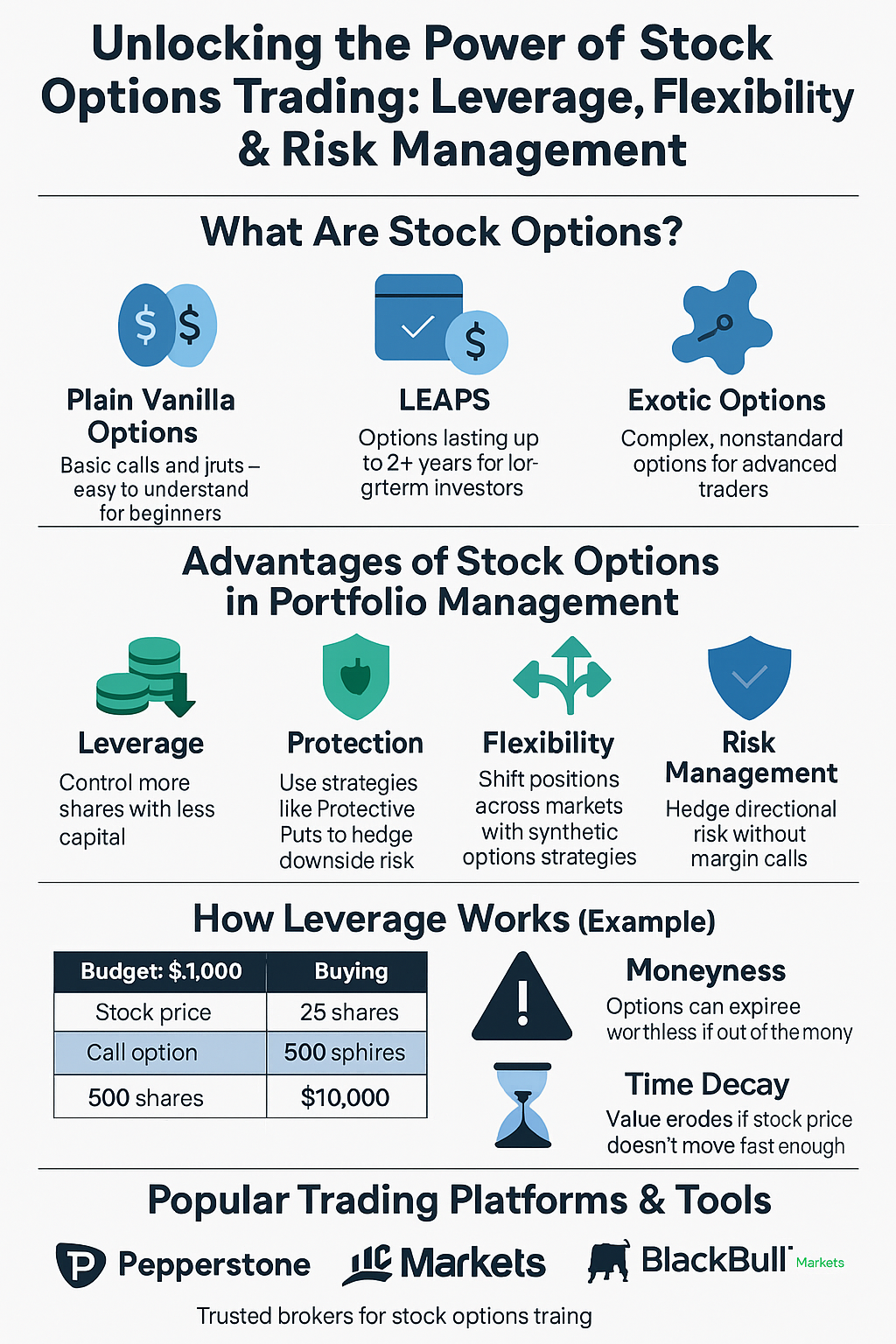
One of the strategies of successful stocks trading is portfolio diversification. This involves combining various strategies and income-generating approaches to strengthen investment portfolios.
The immediate benefits of trading stock options for portfolio diversification are protecting your investments and profiting from market movements. But there’s more and the post goes into the full details.
Many stock traders hold diverse investments such as stocks, bonds, and mutual funds. The complex world of money and stock markets offers numerous securities that provide a plethora of opportunities for traders to consolidate and grow their portfolios.
Stock options trading is one of the most effective ways to diversify a trading and investment portfolio. While often suited for sophisticated traders and investors, anyone willing to learn the fundamentals of stock options trading can succeed in this realm.
What Are the Benefits of Options in Portfolio Management?
Beyond diversification, stock options trading offers several advantages. The power of options lies in their versatility, allowing traders to adjust their positions dynamically according to market movements. Options can be used both conservatively and speculatively:
- Protective strategies help safeguard investments from market declines.
- Speculative strategies enable traders to profit from anticipated market or index movements.
This flexibility means traders can strategize around protecting their capital while also having the opportunity to benefit from market volatility.
Long-term Advantages of LEAPS Options Trading
Among options strategies, LEAPS (Long-Term Equity Anticipation Securities) provide unique benefits for long-term portfolio management. LEAPS allow traders to hold options contracts with expiries extending over a year, offering extended time to realize gains or hedge positions, making them valuable tools for portfolio diversification and risk management.
Protective Put Strategy in Stock Options Trading
The protective put strategy is a popular risk management technique where traders buy put options to guard their stock holdings against potential declines. This strategy acts like insurance, limiting downside risk while retaining upside potential.
Understanding the Risks in Options Trading
However, juggling these possibilities is not without costs. Options are part of a complex securities cluster and can be very risky.
This is why options trading usually comes with a stern disclaimer:
“Options involve risks and are not suitable for everyone. Option trading can be speculative in nature and carry substantial risk of loss. Only invest with risk capital.”
Educating yourself on the advantages and risks of stock options trading is the best way to determine if this trading style fits your risk tolerance and goals.
As one of the top billionaires famously said, risk is not knowing what you are doing. Approaching options trading without proper knowledge is a surefire way to incur losses.
A good starting point is enrolling in a comprehensive stock options trading course and learning the fundamentals.
Many modern platforms offer excellent educational resources and simulated trading environments — for example, Pepperstone and IC Markets provide accessible options trading alongside robust charting tools via TradingView, enabling traders to practice strategies risk-free.
Types of Options
The elementary calls and puts options are often referred to as plain vanilla options. These are the easiest types of options, and any beginner trader can quickly grasp how they work. Options can also be broadly classified into two main categories: Long-Term Options and Exotic Options.
LEAPS: Long-Term Equity Anticipation Securities
Many traders are familiar with short-term options. However, there are options with holding periods that can stretch up to a year, two years, or even longer. These are suitable for long-term investors and are known as Long-Term Equity Anticipation Securities (LEAPS).
LEAPS operate similarly to regular options, enabling holders to both speculate on price movements and manage risk. The primary advantage of LEAPS is the extended timeframe they provide for these opportunities.
Although LEAPS are not available on all stocks, they are offered on many widely held issues, making them a valuable tool for portfolio diversification and long-term strategy.
Exotic Options: Versatile and Complex Variations
Due to the versatile and robust nature of options, traders can encounter or create many nonstandard variations known as Exotic Options. These are either variations or extensions of the payoff profiles of simple calls and puts (vanilla options) or entirely different products that include optionality features.
Exotic options can be complex and are generally suited for advanced traders. For a deeper understanding of these sophisticated option types, this Investopedia resource offers a clear explanation of the differences between exotic and standard options.
Benefits of Stock Options Trading Leverage
You might wonder why trade stock options when you could gain from upward and downward market movements simply by buying or shorting shares. Or, why not trade futures, which typically offer even greater leverage?
Stock options trading offers unique leverage benefits that set it apart. Options allow traders to control larger positions with a relatively small capital outlay, which can amplify potential returns while also enabling various risk management strategies.
Modern brokers such as Pepperstone, IC Markets, and BlackBull Markets provide access to a wide range of stock options with competitive fees and powerful trading platforms. Additionally, charting and analysis tools from TradingView help traders evaluate leverage opportunities more effectively.
Stock Options Trading Leverage Explained
Stock options offer a great deal of leverage. They can be bought at a small fraction of the price of the underlying stock, while representing the same number of shares. This enables a trader to control the profits of the same amount of shares using a smaller amount of risk capital.
Put simply, with the amount you could use to buy shares, you can control a comparatively larger amount of stock through options trading. Leverage is defined as the power to control more shares with less capital.
Stock Options Trading Leverage Example
Here is an example demonstrating the benefits of stock options trading leverage:
Let’s say you have $1,000 to buy shares of Company A, which is trading at $40 per share. The same company has call options with a $40 strike price trading at $2.00. This means you can buy 25 shares of Company A by purchasing the stock directly ($1,000 / $40 = 25 shares).
Alternatively, you could control 500 shares by buying 2 contracts of its call options ($1,000 / $2 = 500 shares).
From this example, it’s clear that controlling more shares with the same amount of money provides far greater profitability potential in stock options trading compared to buying the underlying shares outright.
If Company A’s stock rallies from $40 to $60, buying the shares would result in a profit of:
($60 – $40) × 25 = $500
Whereas buying call options would mean:
($60 – $40) × 500 = $10,000 profit.
This clearly illustrates the powerful leverage benefits available through stock options trading.
Other Benefits of Stock Options Trading
Beyond leverage, stock options offer additional advantages:
Protection: Buying options can function like insurance. For example, through the protective put strategy, a trader can sell stock at the strike price regardless of how low the stock price falls.
This hedging capability was the original purpose of stock options, making them ideal for managing directional risk without margin implications.
Flexibility: Options enable traders to shift between markets or adjust positions easily through synthetic positions and options strategies. This flexibility helps traders position themselves for profit even if their stocks decline.
Understanding the Risks: Moneyness and Time Decay
It is important to acknowledge that stock options trading carries risks:
- If an option expires out of the money, the contract becomes worthless, resulting in a total loss of the premium paid. Traders should understand the concept of options moneyness to manage this risk effectively. For more, see this Options Moneyness resource.
- Time decay affects the value of options. If a stock does not rally quickly enough after buying a call option, the option‘s value will diminish over time, possibly leading to a loss even if the stock price eventually rises.
FAQs
What is a major benefit of portfolio diversification?
To recap- portfolio diversification helps reduce risk by spreading investments across different assets, reducing exposure to any single security.
Why trade stock options instead of stocks or futures?
The advantages of stock options include the ability to leverage positions with less capital, manage risk through protective strategies, and gain flexibility in trading approaches.
What is the advantage of trading options?
The advantages of stock options include leverage, protection against downside risk, and strategic flexibility.
How is asset allocation different from diversification?
Asset allocation involves deciding how much capital to assign to different asset classes, while diversification refers to spreading investments within those classes to reduce risk.
Final Thoughts
Stock options trading offers a gold mine of opportunity for traders willing to understand how it works. By mastering concepts such as options moneyness and building solid trade management strategies, traders can reap significant benefits.
Many brokers like Pepperstone and IC Markets provide excellent platforms for trading stock options, combined with powerful charting tools from TradingView to help analyse market conditions and manage trades effectively.
Elias Stroud is a professional forex trader and market analyst with over eight years of experience. His journey began with the common misconception that trading was a get-rich-quick scheme, a path that led to significant early losses. It was this initial failure that forced a pivot towards disciplined, long-term learning and strategy development.
Today, Elias specializes in price action analysis, focusing on identifying high-probability setups without relying on complex indicators. He has cultivated a premium-level trading account, a direct result of his commitment to a structured and professional approach to the markets. Elias is passionate about sharing the actionable insights and foundational principles that helped him transform from a novice to a consistently profitable trader.
For further verification of his professional standing and live trading credentials, please visit the “About Us” page where account confirmation screenshots are provided, along with links to his trusted broker, Pepperstone, and his primary charting platform, TradingView.

